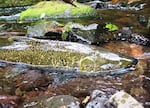About two dozen projects aimed at saving imperiled fish and amphibians are getting a share of $10 million, the first round of grants to come out of Oregon’s landmark agreement on managing private forest lands.
For years, conservationists and timber industry groups debated how to protect fish, frogs and salamanders while also logging trees on 10 million acres of privately owned lands. They came to an agreement called the Private Forest Accord, signed by former Gov. Kate Brown in 2022.
As part of the agreement, the state would pool money into a grant program for habitat conservation projects around the state. This year, about $10 million were awarded to 25 projects in western and southern Oregon, and a couple in northeastern Oregon.
“Different organizations are really looking to this new source of funding as a way to help get projects done, move things through, and advance really key projects in their regions,” Wild Salmon Center policy director Stacey Detwiler said.

FILE: A Chinook salmon. Oregon's Private Forest Accord brought regulations that aim to protect fish, as well as grant funding for projects to improve their habitat.
Courtesy of Oregon State University
The grants range from $50,000 to $1.7 million. Among them, Johnson Creek, flowing through East Portland, will get new woody debris structures built downstream from the Leach Botanical Garden. These structures will help shade juvenile salmon, steelhead and lamprey. The Johnson Creek Watershed received $125,000 for this project.
The largest grant is going toward estuaries north of Reedsport in southwestern Oregon. It will fund several infrastructure projects for ranches and native salmon and trout, including replacing tide gates along the Lower Smith River. Tide gates protect farms and ranches from river floods while allowing fish to pass. That grant’s funds are also going toward concrete bridges for a nearby ranch.
The Oregon Department of Fish and Wildlife is preparing to accept applications this fall for the next round of grants amounting to $10 million. Funding for subsequent rounds of grants will depend on how much lawmakers want to spend in the next 2025-2027 biennial budget, which Gov. Tina Kotek’s office is working on.
In addition to the grant program, the Private Forest Accord ushered in logging regulations aimed at protecting sensitive fish and other aquatic species. Among the changes, the accord increased stream buffers so timber companies don’t log too close to moving water, and it requires them to leave more trees behind when logging on steep slopes.
Those regulations, the grant program and the entirety of the Private Forest Accord expire in 2027 if the state doesn’t finalize a habitat conservation plan for private lands by that year. That plan would be a document that tells federal officials how the state will protect federally endangered species from logging. The Oregon Department of Forestry is finalizing its draft to submit to the U.S. Forest Service next month.
The state is simultaneously working to finish its state forests habitat conservation plan for 640,000 acres managed by the Oregon Department of Forestry.
